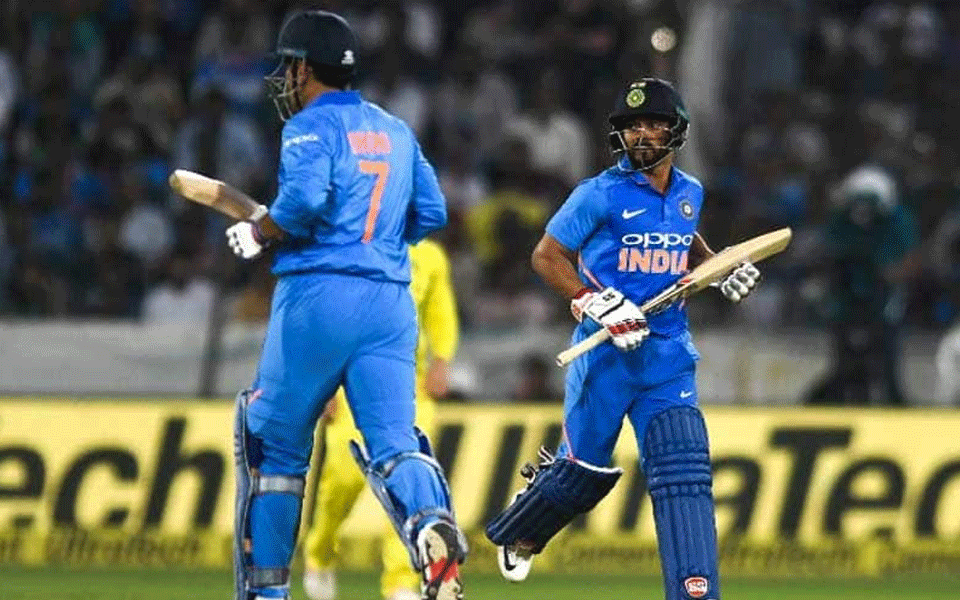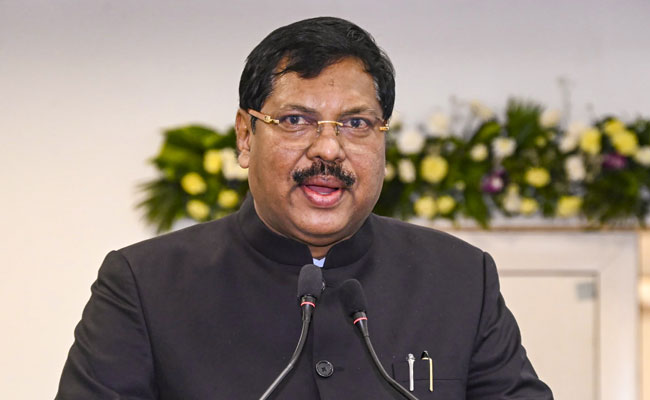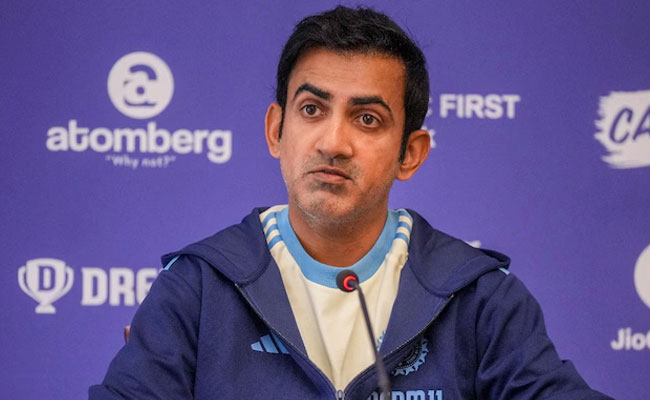Hyderabad, Mar 2: Mahendra Singh Dhoni took a chase deep for the umpteenth time but it needed Kedar Jadhav's street smartness to get India back on winning track as they beat Australia by six wickets in the first ODI here Saturday.
India reached the target in 48.2 overs, riding on a 141-run unconquered stand between Kedar (81 no, 87 balls) and Dhoni (59 no off 72 balls), to take a 1-0 lead in the five-match series.
India had lost the two preceding T20 Internationals.
Clad in their brand new jerseys, the successful chase of 237 was a throwback to the good old 90's when Ajay Jadeja and Robin Singh would hunt down those sub 250 totals in exciting finishes.
However, it shouldn't be lost in isolation that India made a heavy weather of an easy target on a not so difficult wicket.
As has been the case these days, Dhoni was once again unable to rotate the strike at the start of his innings and the onus was on Kedar to hit the boundaries after they joined hands at 99 for four with skipper Virat Kohli (44, 45 balls) and his deputy Rohit Sharma (37, 66 balls) back in the hut.
While Dhoni hit six fours and a six off Nathan Coulter-Nile, it was the diminutive Maharashtra man, who did the hard yards of finding the gaps.
Be it the inside out boundaries off Adam Zampa or those cheeky tennis ball dabs off his hips or a steer through the third man, Kedar was everything that Dhoni needed in those middle overs.
On the way to his fifth half-century, Kedar hit nine fours and a six as he upped the ante once Dhoni started suffering from cramps, getting those big shots out of the closet.
That age is catching up was visible when Dhoni was taking those doubles on big Australian grounds but he did enough to complete his 71st half-century in his 339th ODI. Fittingly, Dhoni finished the game with successive boundaries off Marcus Stoinis.
In the afternoon, Indian bowlers controlled the proceedings like seasoned puppeteers, pulling strings at will to restrict Australia to a sub-par 236 for 7.
It was a vastly different performance from the bowling unit which maintained discipline for the better part of the 50 overs with Mohammed Shami (2/44 in 10 overs) showing the way.
Kuldeep Yadav (2/46 in 10 overs), Ravindra Jadeja (0/33 in 10 overs) and Kedar Jadhav (1/31) made up for a rare off-day that Jasprit Bumrah (2/60 in 10 overs), had by his standards.
Even Usman Khawaja (50) and Glenn Maxwell (40), despite being the top two contributors, weren't exactly comfortable against an Indian attack that bowled as many as 169 dot balls.
This effectively meant Australia couldn't score 28.1 overs out of the 50 overs during Indian innings.
What the statistics won't reveal is the contribution of Kedar as the sixth bowler and Jadeja, who stifled the Aussies during the second Powerplay.
This was after Shami bowled a brilliant wicketless first spell which was seen off by Stoinis (37, 53 balls) and Khawaja (50, 76 balls), who added 87 runs for the second wicket after early dismissal of Aaron Finch.
It was Khawaja, who was first to break the shackles with a cover drive off Bumrah and a six off Kuldeep, introduced in the last over of the first Powerplay.
With only 38 runs coming in the first Powerplay, the duo especially Stoinis decided to up the ante against Indian bowling's weakest link Vijay Shankar (0/22 in 3 overs), hitting him for a flurry of boundaries.
In the next five overs, Australia scored 33 and looked like regaining ground when Jadhav (1/31 from 7 overs) got a lucky breakthrough with a rank half-tracker. Stoinis mistimed the pull shot to Virat Kohli at mid-wicket.
Khawaja completed his sixth half-century in ODIs but couldn't get the elevation while giving Kuldeep the charge. Shankar took a well-judged catch at deep mid-wicket boundary running sideways.
Maxwell joined Peter Handscomb at 97 for three and the duo farmed the strike well during their run-a-ball partnership.
Handscomb was using his feet well but Kuldeep managed to produce a classical chinaman's delivery. Handscomb was deceived twice first in the air and then it broke back sharply for Dhoni to complete the easiest of glovework.
Once Handscomb was out, India controlled the second Powerplay with Kedar and Jadeja choking the run-flow.
Despite not getting wickets, Jadeja bowled two miserly spells 5-0-15-0 and 5-0-18-0. To top it, he was hit for only two boundaries and bowled 34 dot balls which kept the visitors under tight leash.
Let the Truth be known. If you read VB and like VB, please be a VB Supporter and Help us deliver the Truth to one and all.
Latur (PTI): A minor girl was allegedly kidnapped and raped by an 18-year-old man in Latur, leading to the arrest of the main accused and owners of two cafes where the crime occurred on December 4, police said on Saturday.
Police traced the girl within hours of registering the complaint. The accused, identified as Rihan Gulab Shaikh, was arrested based on the girl's complaint. Two others are owners of two cafes where the crime occurred, police said.
Police registered a case under various sections of the Bharatiya Nyay Sanhita (BNS), POCSO Act, and the Prevention of Atrocities Act, an official said.





